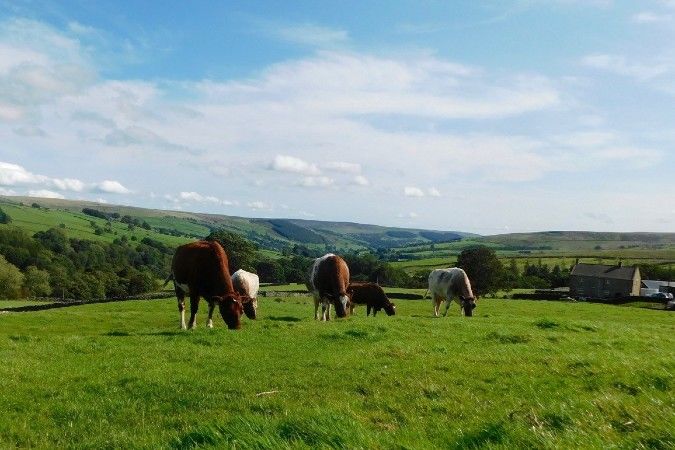The search for the best British cheeses could be a never ending task. However, we aren’t complaining about exploring some of the best wine and cheese pairings Britain has to offer. In the cheesemaking world, there’s been a shift towards traditional methods that were lost during the 1970s factory boom. While cheeses like Cheddar, Red Leicester and Wensleydale were once relegated to dull sandwich filler status, producers are now reviving farmhouse versions of these British cheeses using old recipes often passed down through families – some even discovered handwritten and hidden in farmhouse drawers. Cheesemonger and author Ned Palmer calls these British cheeses ‘the territorials’ and says the trend towards reviving them has been in momentum for the past ten years. ‘These cheeses are unique. They’re made from cow’s milk, they’re quite mild and essentially very British – no one else makes anything like them,’ he says.

(Photo: Neal's Yard Dairy)
The move towards this kind of cheesemaking might have also been fuelled by necessity. During the UK lockdown, cheesemongers suffered from a lack of wholesale orders from restaurants, meaning soft cheeses with a shorter shelf life went to waste. This prompted the production of a whole new generation of hard British cheeses that would last longer. ‘I thought it was going to destroy cheese, I was so worried about it,’ says Palmer. ‘What actually happened is that people started making new cheeses, which was a great result.’
It’s interesting and brave work, bringing back some of our traditional British cheeses and appreciating them for what they are
The action playing out on cheese counters up and down the British Isles confirms this trend, with Estelle Reynolds, retail manager at London’s Covent Garden cheese shop Neal’s Yard Dairy stating that, surprisingly, Wensleydale has had ‘the biggest impact’ across their stores. She claims the shift towards heritage British cheeses is related to a wider interest in where our food comes from. ‘Customers don’t necessarily know what it is that they want, but they want to talk about provenance and sustainability,’ says Reynolds. According to Reynolds, British cheese fans are also increasingly interested in the stories behind their purchases, especially if there’s a local link. ‘People really are looking for something with a story and are looking for a producer that kind of resonates with their values,’ she adds.

(Photo: Nic Crilly-Hargrave)
This new wave of British cheese is pioneered by producers, both established and new, who are using heritage techniques, different milks and new washes (even incorporating the use of other traditional British produce like cider), to reinvigorate British cheese. Although, this doesn’t mean other cheeses such as blues and goat’s or sheep’s milk varieties are falling out of fashion. As Reynolds says, ‘It’s interesting and brave work, bringing back some of our traditional British cheeses and appreciating them for what they are.’
Read on for a selection of trending best British cheeses, from heritage hard cheese to beloved British blue. Plus, we asked Fleur de Jong, manager of east London cheese-and-wine shop Funk to share their wine pairing suggestions for each – helping you curate the dream British cheeseboard.
Five trending British cheeses and the wines to sip alongside

Whin Yeats Wensleydale
Made using a recipe from pre-World War Two, this revival of classic farmhouse Wensleydale is an example of one of the bestsellers at Neal’s Yard Dairy, and boasts flavours that range from yoghurt to butter, with a pliant texture and plenty of depth and complexity.
What to drink: Try a white with a little body and character, like Viognier or Chenin Blanc, to match up with the depth of flavour in this cheese.

Pitchfork Cheddar
The world of Cheddar can be a closed one, with many family producers having made the cheese for generations. But Welsh Caerphilly producers the Trethowan Brothers have broken in, making the first ‘proper new Cheddar in around 150 years’ – ‘proper’ meaning the cheese is made with unpasteurised milk from their own herd and then clothbound. This Cheddar is softer than most, with a dense, creamy texture and a lactic bite.
What to drink: Go red with a Pinot Noir, or a lighter style of red that complements the slightly softer texture and less sharp flavour of this Cheddar.

Yarlington Soft Cheese
Although most traditional British cheeses are mild and relatively hard, this washed-rind soft cheese from Gloucestershire has been flying off the shelves in cheese shops all over the UK. Made by cheese expert David Jowett in collaboration with top-notch cidermaker Tom Oliver, the cheese is inspired by Alpine Reblochon and washed in cider, resulting in a gentle, fruity flavour and a silky yet meaty texture.
What to drink: Match Yarlington with a Riesling with good acidity, or even one of Tom Oliver’s ciders to bring out the fruiter notes in the cheese.

Apatha Goat’s Cheese
Made by the Gott family using homemade starter cultures, this lockdown creation came to be after the family took on a herd of goats from Innes cheesemakers in Staffordshire, who decided to retire as a result of the pandemic. The resulting washed-rind cheese is funky, with floral notes as well as a savoury character.
What to drink: Pair this cheese with a rosé – still or sparkling – with citrus notes and good acidity to match up to the tangy, funky flavours.

Lanark Blue
Created in the 1980s, although this British cheese is nothing new, the classic farmhouse style has been intriguing cheese fans with a renewed interest in traditional styles. It’s made with sheep’s milk (and following a recipe written in the 1820s by Sir Walter Scott) and boasts a rich, creamy flavour and powerful blue veining.
What to drink: For pairing, try a medium-sweet sherry to compliment the savoury notes and creamy texture.








